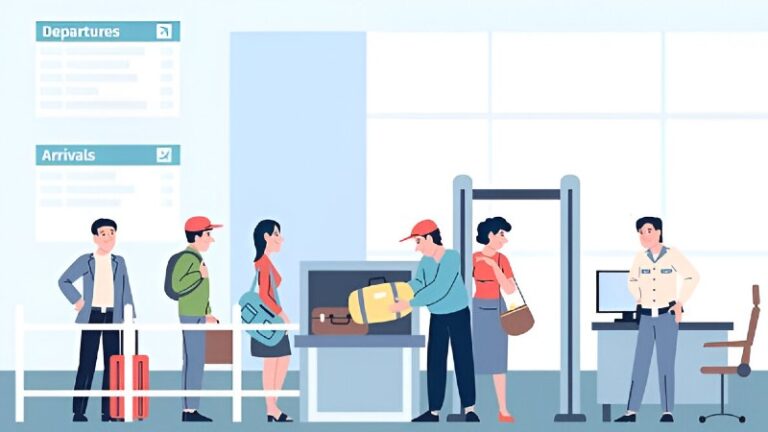Airport security can be one of the most stressful parts of air travel, especially for first-time flyers or those who haven’t flown in years. However, with the right preparation, knowledge, and strategies, you can move through checkpoints efficiently and even enjoy a stress-free start to your journey.
Understanding the Basics of Airport Security
Airport security exists to protect travelers and ensure safe flights, but the process can seem complicated. Understanding the fundamentals can save you time and reduce anxiety.
The Role of TSA and International Counterparts
The Transportation Security Administration (TSA) in the U.S. oversees airport security screening, but most countries have similar agencies. These organizations regulate what passengers can carry in both carry-on and checked luggage. Familiarizing yourself with these rules before traveling is essential to avoid delays and confiscations.
Common Screening Procedures
Security checks typically include:
- Identity verification with government-issued IDs.
- X-ray scanning of bags and carry-ons.
- Metal detector or full-body scanner checks.
- Random additional screening, including pat-downs or swab tests.
Knowing what to expect allows you to prepare and move efficiently through each step.
Packing Smart
While most travelers are aware of the TSA 3-1-1 liquids rule, expert flyers know that strategic packing can significantly speed up your security process.
Optimizing Carry-On Bags
- Place your liquids, gels, and aerosols in a single quart-sized clear bag at the top of your carry-on.
- Use pouches or small containers for electronics accessories, chargers, and cables.
- Pack shoes and belts last for easy removal at the security checkpoint.
- Separate items with trays or packing cubes to reduce the need for manual inspection.
Prohibited vs. Unexpected Items
Beyond obvious prohibited items like firearms and explosives, many travelers are unaware of subtler restrictions:
- Food items like peanut butter, jelly, or gels exceeding 3.4 ounces.
- Large sporting goods, tools, and sharp objects in carry-ons.
- Lithium-ion batteries should be packed in your carry-on, not checked luggage, to mitigate fire risks.
Using the TSA What Can I Bring? tool can provide clarity on nearly every item you’re unsure about.
Time Management
Efficient navigation begins with smart planning. Knowing how early to arrive and which lines to use can save significant stress.
Recommended Arrival Times
| Flight Type | Recommended Arrival |
|---|---|
| Domestic | 2 hours before departure (peak seasons: 2.5 hours) |
| International | 3 hours before departure |
Line Selection Strategies
Travelers often overlook simple strategies to reduce wait times:
- Use TSA PreCheck or Global Entry if eligible; these programs expedite screening and reduce the need to remove shoes, belts, and laptops.
- Observe line patterns at regional airports; shorter lines are often found at alternate entrances or less popular checkpoints.
- Avoid peak hours if possible—early mornings and late evenings tend to be faster at most airports.
Advanced Tips for Expert Travelers
For those seeking a pro-level airport security experience, consider strategies beyond basic preparation.
Technology Assistance
- Biometric Screening: Programs like Clear allow identity verification via fingerprint or iris scan, speeding up ID checks.
- CT Scanners: Modern Computed Tomography scanners allow full carry-ons to remain packed, including liquids and electronics, without slowing down screening.
- Travel Apps: Airport apps often provide real-time line estimates and gate updates to optimize your route through the airport.
Optimizing Your Attire
Simple clothing choices can reduce delays:
- Wear shoes that are easy to remove.
- Limit metal accessories like belts, watches, or jewelry.
- Choose lightweight jackets that can remain in your carry-on if TSA PreCheck is available.
Handling Special Situations
Travelers with disabilities, medical conditions, or infants can use TSA Cares for additional assistance. Requesting a Passenger Support Specialist (PSS) ensures a smooth, stress-free experience through the checkpoint.
Practical Examples of Pro-Level Navigation
Consider these scenarios to see how preparation improves security experiences:
Scenario 1: Domestic Business Trip
- Traveler has TSA PreCheck, packs liquids in one clear bag, and organizes electronics in a pouch.
- Arrives 2 hours early and selects the shortest TSA PreCheck line.
- Passes through security in under 5 minutes, no need to remove shoes or laptop.
Scenario 2: International Vacation
- Traveler packs carry-on with 3-1-1 liquids, snacks, and electronics properly separated.
- Uses Global Entry at arrival for fast customs processing.
- Has all IDs, passports, and boarding passes organized in a travel wallet.
- Leaves security in record time, reducing travel stress significantly.
Why Preparation Matters
| Factor | Average Time Saved |
|---|---|
| TSA PreCheck | Up to 20 minutes per checkpoint |
| Global Entry | 25–40 minutes on international return |
| Clear Biometric Screening | 5–10 minutes at ID verification |
| Organized Carry-On | 5–10 minutes avoided from manual bag inspection |
Efficient preparation can reduce the time spent in security by up to an hour, particularly during peak travel periods.
Final Tips for Stress-Free Security
- Check TSA and airline websites before departure for updated regulations.
- Organize identification, boarding passes, and travel documents in one easy-to-access location.
- Pack light and efficiently; fewer items in your carry-on reduces inspection time.
- Use expedited screening programs whenever possible.
- Stay calm, polite, and patient; TSA officers are more efficient when passengers cooperate.
Conclusion
Airport security doesn’t have to be stressful or confusing. By understanding regulations, packing strategically, managing time wisely, and using advanced tools and programs, you can navigate checkpoints like a seasoned traveler. The key to success is preparation—knowing what to expect, staying organized, and planning ahead. With these strategies, even the most complex airports become manageable, allowing you to start your journey relaxed, confident, and ready for takeoff.
Following these expert tips will not only improve your airport experience but can also save valuable travel time, reduce stress, and make flying a more enjoyable part of your trip.
Frequently Asked Questions (FAQs)
What is the best way to pack liquids for airport security?
Follow the TSA 3-1-1 rule: each liquid container must be 3.4 ounces (100 ml) or less, all containers fit in a single quart-sized clear bag, one bag per passenger. Place this bag on top of your carry-on for easy access.
How much time should I arrive before my flight?
For domestic flights, arrive at least 2 hours before departure; during peak travel seasons, 2.5 hours. For international flights, arrive 3 hours early to allow time for check-in, customs, and security.
What items are prohibited in carry-on luggage?
Commonly prohibited items include firearms, large tools, sharp objects, sporting goods, and gel-like foods over 3.4 ounces. Certain items, like lithium-ion batteries, should be packed in your carry-on rather than checked luggage.
How can TSA PreCheck or Global Entry help me?
TSA PreCheck allows faster security screening without removing shoes, belts, jackets, laptops, or compliant liquids. Global Entry includes TSA PreCheck and speeds up re-entry from international travel via automated kiosks.
Can travelers with medical conditions or disabilities get assistance?
Yes, TSA Cares provides assistance for travelers with medical conditions, disabilities, or infants. Passengers can request a Passenger Support Specialist (PSS) to guide them through security checkpoints efficiently.
Are food items allowed through security?
Gel-like foods exceeding 3.4 ounces are not allowed. Medically necessary liquids, infant formula, and liquid nutrition are allowed but must be declared for screening.
How do modern security scanners help speed up the process?
Advanced CT scanners provide 3D imaging of carry-on bags, allowing liquids, electronics, and food to remain packed. This reduces manual inspections and shortens wait times at checkpoints.


